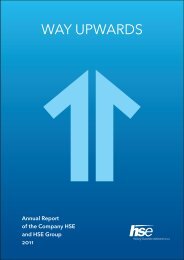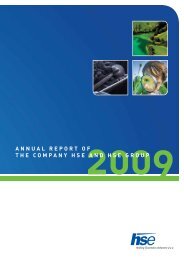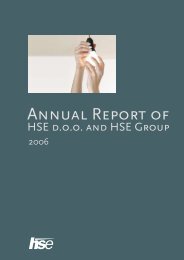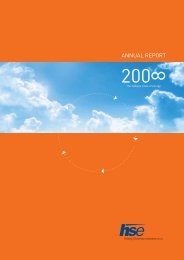Annual report - HSE
Annual report - HSE
Annual report - HSE
You also want an ePaper? Increase the reach of your titles
YUMPU automatically turns print PDFs into web optimized ePapers that Google loves.
4.5.7.6 Impairment of assets<br />
4.5.7.6.1 Financial assets<br />
A financial asset is considered impaired if there is objective evidence from which it is<br />
evident that, due to one or more events, the expected future cash flows arising from this<br />
assets that can be reliably measured have been decreased.<br />
Objective evidence of impairment of financial assets can be: debtor’s non-settlement of<br />
liabilities or breach of contractual provisions; signs that the debtor will go bankrupt.<br />
Impairment of receivables and loans granted<br />
The company individually assesses the evidence on impairment of receivables.<br />
Whether it is assessed that the carrying amount of receivable has exceeded its fair value<br />
(realisable value), the receivable is impaired.<br />
Doubtful receivables from others are those which are not settled within 180 days after<br />
their due date.<br />
Disputed receivables are those which comply with one of the following conditions:<br />
• the legal collection procedure began at the court;<br />
• the decision on beginning of enforced settlement, liquidation or bankruptcy is published.<br />
For receivables at the beginning of bankruptcy proceeding, an allowance in the amount<br />
of 80% of open receivable is created; for disputable receivables 20% of the amount<br />
claimed; for receivables subject to enforced settlement that have not been confirmed<br />
yet it represents 50% of the amount claimed in the forced settlement proceeding. The<br />
percentage may change, if taking into account circumstances and facts of individual case.<br />
For subsequent write-offs of receivables relevant documents of proof are needed: legally<br />
enforceable decisions of enforced settlement, bankruptcy proceeding, court ruling or<br />
other relevant document.<br />
In case all actions were performed with the carefulness of a good manager, with intention<br />
to repay certain unsettled receivable and in case that due to the amount of receivable, it<br />
would not be economic for the company to enter the collection procedure through court,<br />
receivables are finally written down in full based on the management’s decision.<br />
The company assesses evidence on loan impairment for each significant loan.<br />
Loss due to impairment related to financial asset carried at amortised cost is calculated as<br />
difference between the carrying amount of an asset and expected cash flows discounted<br />
at historical interest rate. Loss is recognised in profit or loss.<br />
4.5.7.6.2 Non-financial assets<br />
On each <strong>report</strong>ing date the company verifies the carrying amount of significant nonfinancial<br />
assets with the purpose to establish whether there are any signs of impairment. If<br />
such signs exist, the recoverable amount of the asset is estimated.<br />
The recoverable amount of an asset or cash-generating unit is the higher of the two: value<br />
in use or fair value less costs of sale. When determining the value of an asset in use, the<br />
expected future cash flows are discounted to their current value by using the discount rate<br />
before tax that reflects regular market assessments of the time value of money and risks<br />
that typically occur in relation to the asset. For the purpose of impairment test, the assets<br />
that cannot be individually tested are classified in the smallest possible group of assets<br />
that generate cash flows from further use and are mostly independent from receipts of<br />
other assets and groups of assets (cash-generating unit).<br />
The impairment of an asset or the cash-generating unit is recognised when its carrying<br />
amount exceeds its recoverable amount. Impairment is disclosed in the income statement.<br />
<strong>Annual</strong> Report <strong>HSE</strong> 2012<br />
4 Financial Report of the company <strong>HSE</strong><br />
123



